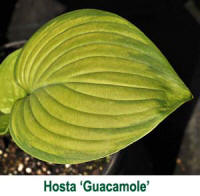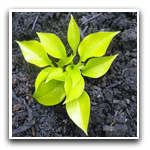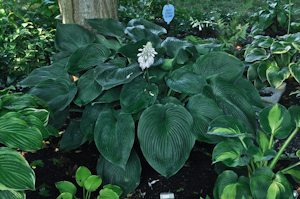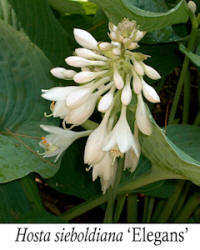 In addition to identifying the
43 species,
Schmid (1991) determined that 32 plants that were traditionally
treated as species really did not qualify for that status. He
recommended reclassifying these "species" as cultivars i.e.
cultivated varieties.
In addition to identifying the
43 species,
Schmid (1991) determined that 32 plants that were traditionally
treated as species really did not qualify for that status. He
recommended reclassifying these "species" as cultivars i.e.
cultivated varieties.
The key reason was that there was no evidence
that these plants ever existed as natural, "wild" populations. In
fact, it appears that most of them were actually plants developed in
nurseries by selection or through seedling propagation of crosses of
unknown plants. This happened back in previous centuries in either
their native Asian lands or after they had been brought to Europe
and no records were kept on the plant's true history.

Hostas previously thought to be species or
botanical varieties but transferred to cultivar status by
Schmid
(1991) include:
Mr. PGC Link: HostaHelper information on
Hosta Species...
 Mr.
Schmid continues his study of the genus,
Hosta, and proposed another change affecting one of the
all-time classic plants,
Hosta sieboldiana.
In his 2010 Species
Update, W. George
Schmid examined the origins of what was then the species, Hosta sieboldiana. The
sports and hybrids of this plant account for more different cultivars in home
gardens than any other hosta. In his extensive study, Schmid concluded that the
plant grown in our gardens as H. sieboldiana is actually a hybrid
cultivar developed in Europe after it was imported there from Japan by
Philip von Siebold
in 1862.
One of the key factors in defining a species is that it may be found in the
"wild" and that does not appear to apply to this hosta.
Therefore, the proper name for this plant is H. ‘Sieboldiana’.
Mr.
Schmid continues his study of the genus,
Hosta, and proposed another change affecting one of the
all-time classic plants,
Hosta sieboldiana.
In his 2010 Species
Update, W. George
Schmid examined the origins of what was then the species, Hosta sieboldiana. The
sports and hybrids of this plant account for more different cultivars in home
gardens than any other hosta. In his extensive study, Schmid concluded that the
plant grown in our gardens as H. sieboldiana is actually a hybrid
cultivar developed in Europe after it was imported there from Japan by
Philip von Siebold
in 1862.
One of the key factors in defining a species is that it may be found in the
"wild" and that does not appear to apply to this hosta.
Therefore, the proper name for this plant is H. ‘Sieboldiana’.
Kevin Walek,
International Registrar for the Genus, Hosta made the
following statement in his 2011 Registrations report:
 "In a recent
article
W. George Schmid has
proposed that the taxon H. sieboldiana be reduced to cultivar
rank in accordance with the International Code of Nomenclature for
Cultivated Plants (ICNCP). Refer to
The American Hosta Society 2011
Online Hosta Journal, Vol. 42; under the section "Genus Hosta" by W.G. Schmid: H. sieboldiana or H. 'Sieboldiana': Species or
Cultivar? or refer to the AHS 'Tan Book' (List of Species, Botanical
Varieties, and Forms (under the International Code of Botanical
Nomenclature (VIENNA CODE) and Species reduced to Cultivar Rank
(under the ICNCP) posted on the
AHS web site.
The applicable plant description and synonyms are published in W.G.
Schmid (1991) The Genus Hosta - Giboshi Zoku; Chapter 3, Part
2; Pages 93-94; 317-318. Timber Press; Portland, Oregon, USA.
"In a recent
article
W. George Schmid has
proposed that the taxon H. sieboldiana be reduced to cultivar
rank in accordance with the International Code of Nomenclature for
Cultivated Plants (ICNCP). Refer to
The American Hosta Society 2011
Online Hosta Journal, Vol. 42; under the section "Genus Hosta" by W.G. Schmid: H. sieboldiana or H. 'Sieboldiana': Species or
Cultivar? or refer to the AHS 'Tan Book' (List of Species, Botanical
Varieties, and Forms (under the International Code of Botanical
Nomenclature (VIENNA CODE) and Species reduced to Cultivar Rank
(under the ICNCP) posted on the
AHS web site.
The applicable plant description and synonyms are published in W.G.
Schmid (1991) The Genus Hosta - Giboshi Zoku; Chapter 3, Part
2; Pages 93-94; 317-318. Timber Press; Portland, Oregon, USA.

 Tthis change has been officially adopted by The American Hosta Society,
but there
seems to be ongoing disagreement concerning this change among some
Hostaphiles.
At the January 19, 2013
Hosta Scientific Meeting in Lisle, IL,
Mark Zilis, author of
The Hostapedia, stated that Japanese hosta explorers think they
have discovered a wild population of
H. sieboldiana living on
a remote part of one of the islands of
Japan.
Tthis change has been officially adopted by The American Hosta Society,
but there
seems to be ongoing disagreement concerning this change among some
Hostaphiles.
At the January 19, 2013
Hosta Scientific Meeting in Lisle, IL,
Mark Zilis, author of
The Hostapedia, stated that Japanese hosta explorers think they
have discovered a wild population of
H. sieboldiana living on
a remote part of one of the islands of
Japan.
Bob Solberg of
Green Hill Farm in North Carolina in
The
Hosta Journal (2018 Vol. 49 No 2) states that he and
Mark Zilis of
T&Z or Q&Z Nursery in Illinois
on a recent trip to Japan found at least one example of the species form of H. 'Sieboldiana' growing in the wild.
In the end, this change in nomenclature has been adopted by The
American Hosta Society so we will use the form H. 'Sieboldiana'
in our pages until or unless there is another change..




